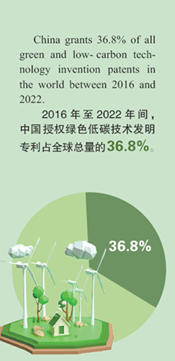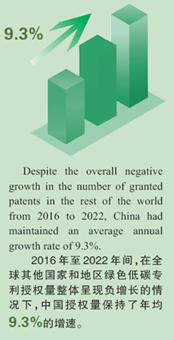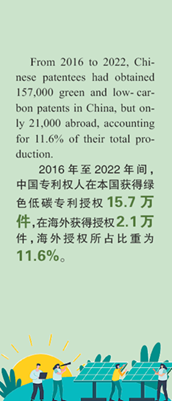Source:China IP News




Shifting to green and low-carbon has become a global trend though the challenges cannot be discounted with many countries undergoing a slowdown in green-oriented transition of energy and the global focus of green development shifting eastward. The Statistical Analysis Report on Global Green and Low-carbon Technology Patents (2023) (Report), edited and released by the Strategic Planning Department of the China National Intellectual Administration (CNIPA), shows that China has been playing an important role in leading global green and low-carbon technology innovation, and China granted 36.8% of all green and low-carbon technology invention patents in the world between 2016 and 2022.
"Facing the uncertainty of global green development, China has upheld the principle of 'establishing the new before abolishing the old and pursuing progress while ensuring stability' for green and low-carbon technology innovation, formed a trend of active development, and gathered increasingly strong strength for green and sustainable development," said Cai Rui, Director of the Energy Strategy Research Center, Dalian Institute of Chemical Physics, Chinese Academy of Sciences.
Increasingly active green innovation
According to the Report, despite the overall negative growth in the number of granted patents in the rest of the world from 2016 to 2022, China had maintained an average annual growth rate of 9.3%. China had 13 of the world's top 50 patent owners, ranking second among countries. When it comes to the technical field of carbon reduction in fossil energy amongst others, a dominant portion of growth in patents is contributed by China.
"Since China set the goal of carbon peaking and carbon neutrality in 2020, it has captured great attention from the public with visible influx of capital, technologies and talents into carbon neutrality technologies, and in particular, the proportion of primary market investment in this field has increased significantly. According to statistics, investments in carbon neutrality technologies in 2021 surged by 180% year on year, and relevant investment value accounted for nearly 14% of all capital in the primary market, which has propped up green and low-carbon technology innovation. The release of policy measures has also boosted the growth of green technology demand, pushing forward the establishment and continuous improvement of a market-oriented green technology innovation system," said Xie Hongxing, Director of the Secretariat of the Bluetech Clean Air Alliance.
"China's resource endowments such as tremendous research strength, complete industrial chain and broad market appeal strongly to foreign innovators and business entities, which have further promoted the gathering and flow of green and low-carbon innovation factors in the domestic market," said Xie, adding that all these are important drivers for China to increase investments in green low-carbon technology innovation and accelerate industrialization.
Unstoppable trend of coordinated development
Though China has initially gained some comparative edge in technologies and industries related to green and low-carbon innovation, there is still much room for improvement in IPR planning, commercialization and value enrichment. The Report reveals that Chinese innovators remain weak in planning of green and low-carbon patents in the oversea market. From 2016 to 2022, Chinese patentees had obtained 157,000 green and low-carbon patents in China, but only 21,000 abroad, accounting for only 11.6% of their total production, way behind their competitors from the U.S., Japan and Europe.
A coordinated low-carbon development of regions is the key to achieving carbon peaking and carbon neutrality. According to the Report, as far as China's key areas for green and low-carbon technology innovation are concerned, the Yangtze River Delta, the Beijing-Tianjin-Hebei region, and the Guangdong-Hong Kong-Macao Greater Bay Area have stronger innovation momentum, though they put weight on different technological fields. Other geographical areas in China loaded with energy resource have become proving grounds for commercializaiton of these green tech innovations.
Cai believed that to promote a coordinated low-carbon development of regions, on the one hand, we should strengthen the coordinated innovation of regions, with the eastern region spearheading the development of the western region and various regions conducting joint research on key green and low-carbon technologies. On the other hand, with focus on building a unified national market, we should coordinate efforts of various regions, steadily advance energy restructuring in the eastern, western, central and northeastern regions, accelerate the transformation of the industrial structure, and promote the smooth flow of energy resources between regions, so as to achieve all-round, coordinated and characteristic development, and make green the brightest highlight in the transformation and upgrading of China's industrial structure, as well as the high-quality economic and social development of China.